Lead and Influence Essay
VerifiedAdded on 2019/10/30
|6
|1521
|152
Essay
AI Summary
This essay analyzes a case study focusing on leadership and influence. The author, a former Human Resource Manager at JoyPond Distributors, recounts a situation where they faced a dilemma: accepting a bribe to bypass the standard hiring process for a vacant Sales Manager position or upholding ethical hiring practices. The essay uses this scenario to explore two leadership theories: trait theory and behavioral theory. Trait theory is critiqued for its difficulty in identifying consistent traits, while behavioral theory is praised for its focus on observable actions and leadership styles. The author's decision to prioritize ethical hiring, despite the company's financial difficulties, is analyzed through the lens of transformational leadership, highlighting the importance of integrity and long-term strategic thinking. The essay concludes by examining both internal (organizational culture) and external (competition) factors influencing the decision-making process. The bibliography lists several academic sources used to support the analysis.
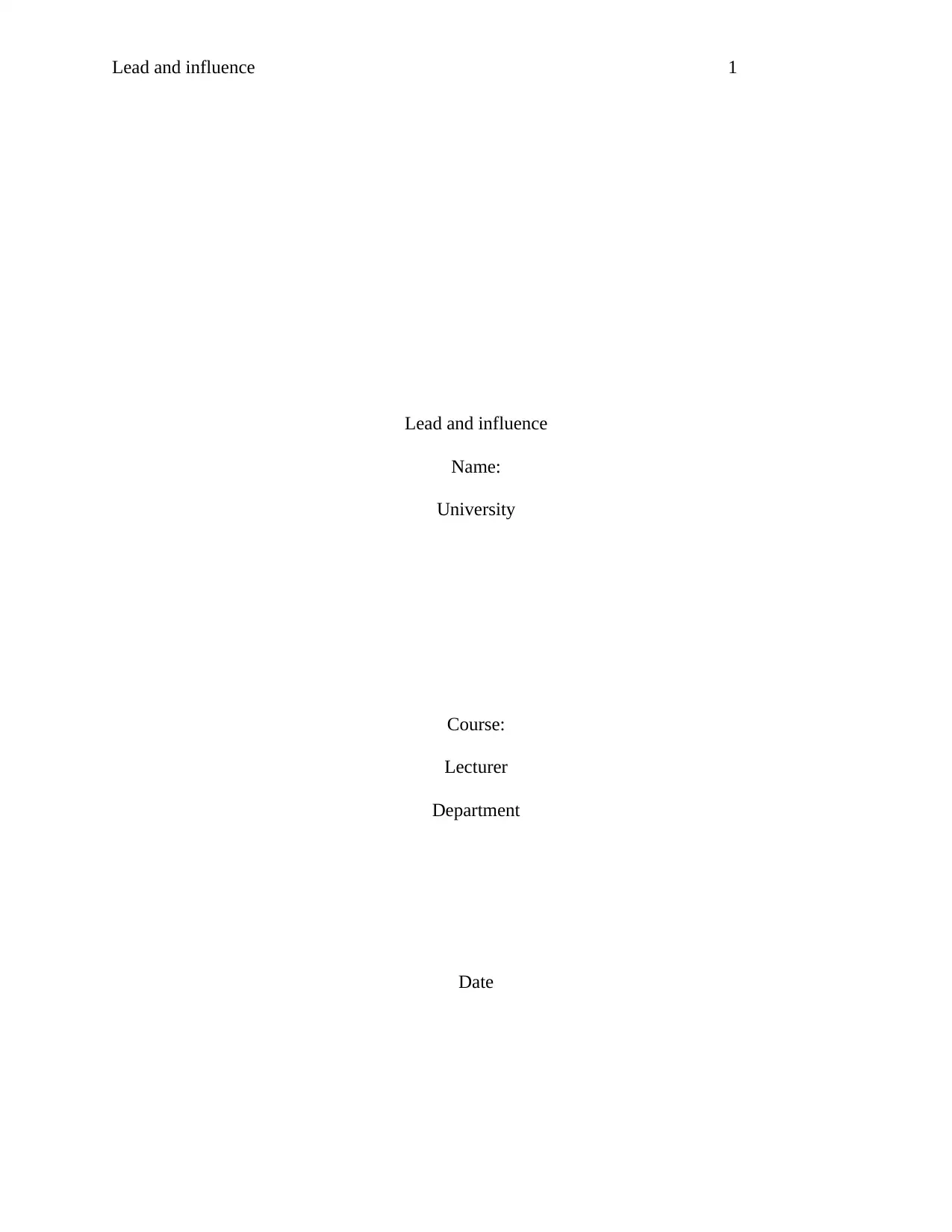
Lead and influence 1
Lead and influence
Name:
University
Course:
Lecturer
Department
Date
Lead and influence
Name:
University
Course:
Lecturer
Department
Date
Paraphrase This Document
Need a fresh take? Get an instant paraphrase of this document with our AI Paraphraser
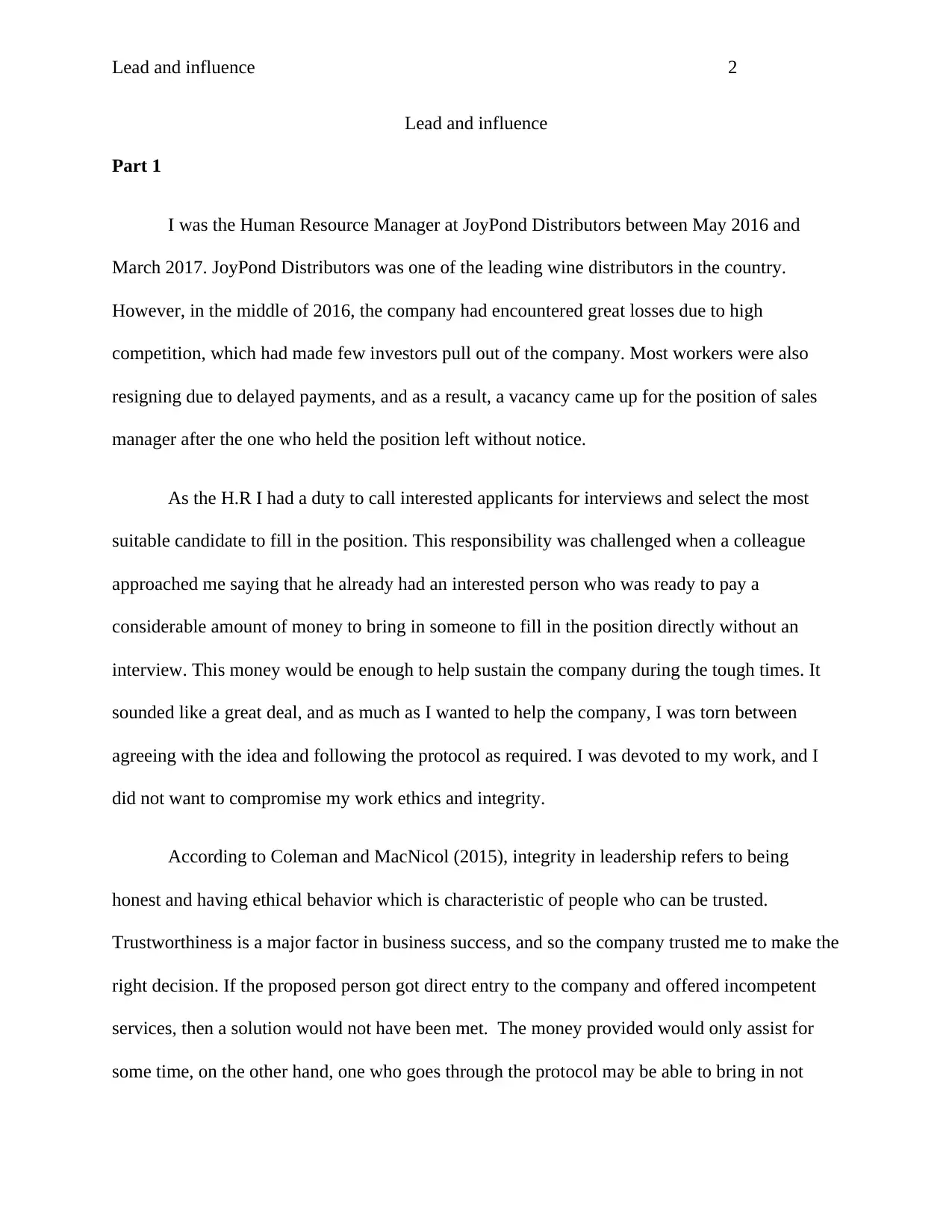
Lead and influence 2
Lead and influence
Part 1
I was the Human Resource Manager at JoyPond Distributors between May 2016 and
March 2017. JoyPond Distributors was one of the leading wine distributors in the country.
However, in the middle of 2016, the company had encountered great losses due to high
competition, which had made few investors pull out of the company. Most workers were also
resigning due to delayed payments, and as a result, a vacancy came up for the position of sales
manager after the one who held the position left without notice.
As the H.R I had a duty to call interested applicants for interviews and select the most
suitable candidate to fill in the position. This responsibility was challenged when a colleague
approached me saying that he already had an interested person who was ready to pay a
considerable amount of money to bring in someone to fill in the position directly without an
interview. This money would be enough to help sustain the company during the tough times. It
sounded like a great deal, and as much as I wanted to help the company, I was torn between
agreeing with the idea and following the protocol as required. I was devoted to my work, and I
did not want to compromise my work ethics and integrity.
According to Coleman and MacNicol (2015), integrity in leadership refers to being
honest and having ethical behavior which is characteristic of people who can be trusted.
Trustworthiness is a major factor in business success, and so the company trusted me to make the
right decision. If the proposed person got direct entry to the company and offered incompetent
services, then a solution would not have been met. The money provided would only assist for
some time, on the other hand, one who goes through the protocol may be able to bring in not
Lead and influence
Part 1
I was the Human Resource Manager at JoyPond Distributors between May 2016 and
March 2017. JoyPond Distributors was one of the leading wine distributors in the country.
However, in the middle of 2016, the company had encountered great losses due to high
competition, which had made few investors pull out of the company. Most workers were also
resigning due to delayed payments, and as a result, a vacancy came up for the position of sales
manager after the one who held the position left without notice.
As the H.R I had a duty to call interested applicants for interviews and select the most
suitable candidate to fill in the position. This responsibility was challenged when a colleague
approached me saying that he already had an interested person who was ready to pay a
considerable amount of money to bring in someone to fill in the position directly without an
interview. This money would be enough to help sustain the company during the tough times. It
sounded like a great deal, and as much as I wanted to help the company, I was torn between
agreeing with the idea and following the protocol as required. I was devoted to my work, and I
did not want to compromise my work ethics and integrity.
According to Coleman and MacNicol (2015), integrity in leadership refers to being
honest and having ethical behavior which is characteristic of people who can be trusted.
Trustworthiness is a major factor in business success, and so the company trusted me to make the
right decision. If the proposed person got direct entry to the company and offered incompetent
services, then a solution would not have been met. The money provided would only assist for
some time, on the other hand, one who goes through the protocol may be able to bring in not
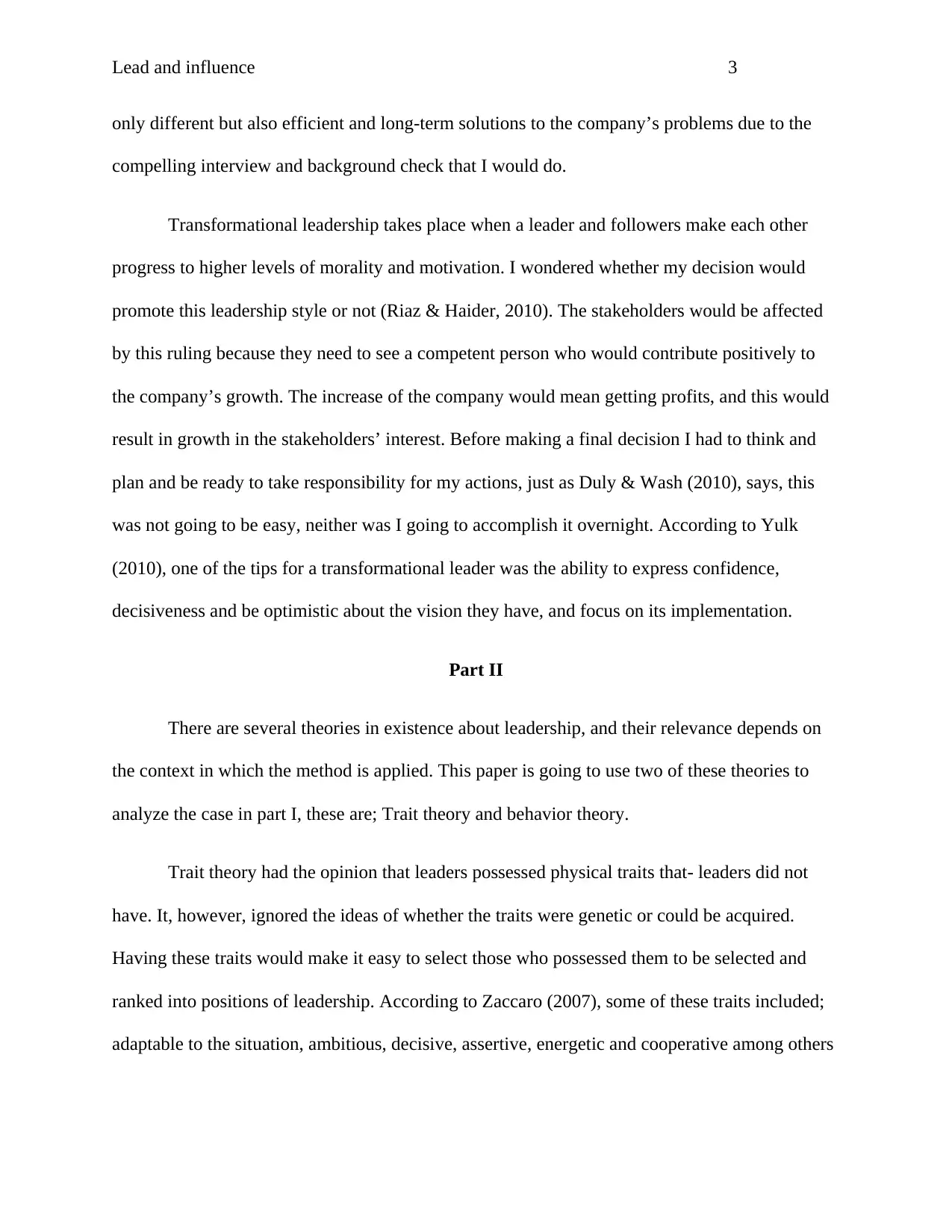
Lead and influence 3
only different but also efficient and long-term solutions to the company’s problems due to the
compelling interview and background check that I would do.
Transformational leadership takes place when a leader and followers make each other
progress to higher levels of morality and motivation. I wondered whether my decision would
promote this leadership style or not (Riaz & Haider, 2010). The stakeholders would be affected
by this ruling because they need to see a competent person who would contribute positively to
the company’s growth. The increase of the company would mean getting profits, and this would
result in growth in the stakeholders’ interest. Before making a final decision I had to think and
plan and be ready to take responsibility for my actions, just as Duly & Wash (2010), says, this
was not going to be easy, neither was I going to accomplish it overnight. According to Yulk
(2010), one of the tips for a transformational leader was the ability to express confidence,
decisiveness and be optimistic about the vision they have, and focus on its implementation.
Part II
There are several theories in existence about leadership, and their relevance depends on
the context in which the method is applied. This paper is going to use two of these theories to
analyze the case in part I, these are; Trait theory and behavior theory.
Trait theory had the opinion that leaders possessed physical traits that- leaders did not
have. It, however, ignored the ideas of whether the traits were genetic or could be acquired.
Having these traits would make it easy to select those who possessed them to be selected and
ranked into positions of leadership. According to Zaccaro (2007), some of these traits included;
adaptable to the situation, ambitious, decisive, assertive, energetic and cooperative among others
only different but also efficient and long-term solutions to the company’s problems due to the
compelling interview and background check that I would do.
Transformational leadership takes place when a leader and followers make each other
progress to higher levels of morality and motivation. I wondered whether my decision would
promote this leadership style or not (Riaz & Haider, 2010). The stakeholders would be affected
by this ruling because they need to see a competent person who would contribute positively to
the company’s growth. The increase of the company would mean getting profits, and this would
result in growth in the stakeholders’ interest. Before making a final decision I had to think and
plan and be ready to take responsibility for my actions, just as Duly & Wash (2010), says, this
was not going to be easy, neither was I going to accomplish it overnight. According to Yulk
(2010), one of the tips for a transformational leader was the ability to express confidence,
decisiveness and be optimistic about the vision they have, and focus on its implementation.
Part II
There are several theories in existence about leadership, and their relevance depends on
the context in which the method is applied. This paper is going to use two of these theories to
analyze the case in part I, these are; Trait theory and behavior theory.
Trait theory had the opinion that leaders possessed physical traits that- leaders did not
have. It, however, ignored the ideas of whether the traits were genetic or could be acquired.
Having these traits would make it easy to select those who possessed them to be selected and
ranked into positions of leadership. According to Zaccaro (2007), some of these traits included;
adaptable to the situation, ambitious, decisive, assertive, energetic and cooperative among others
⊘ This is a preview!⊘
Do you want full access?
Subscribe today to unlock all pages.

Trusted by 1+ million students worldwide
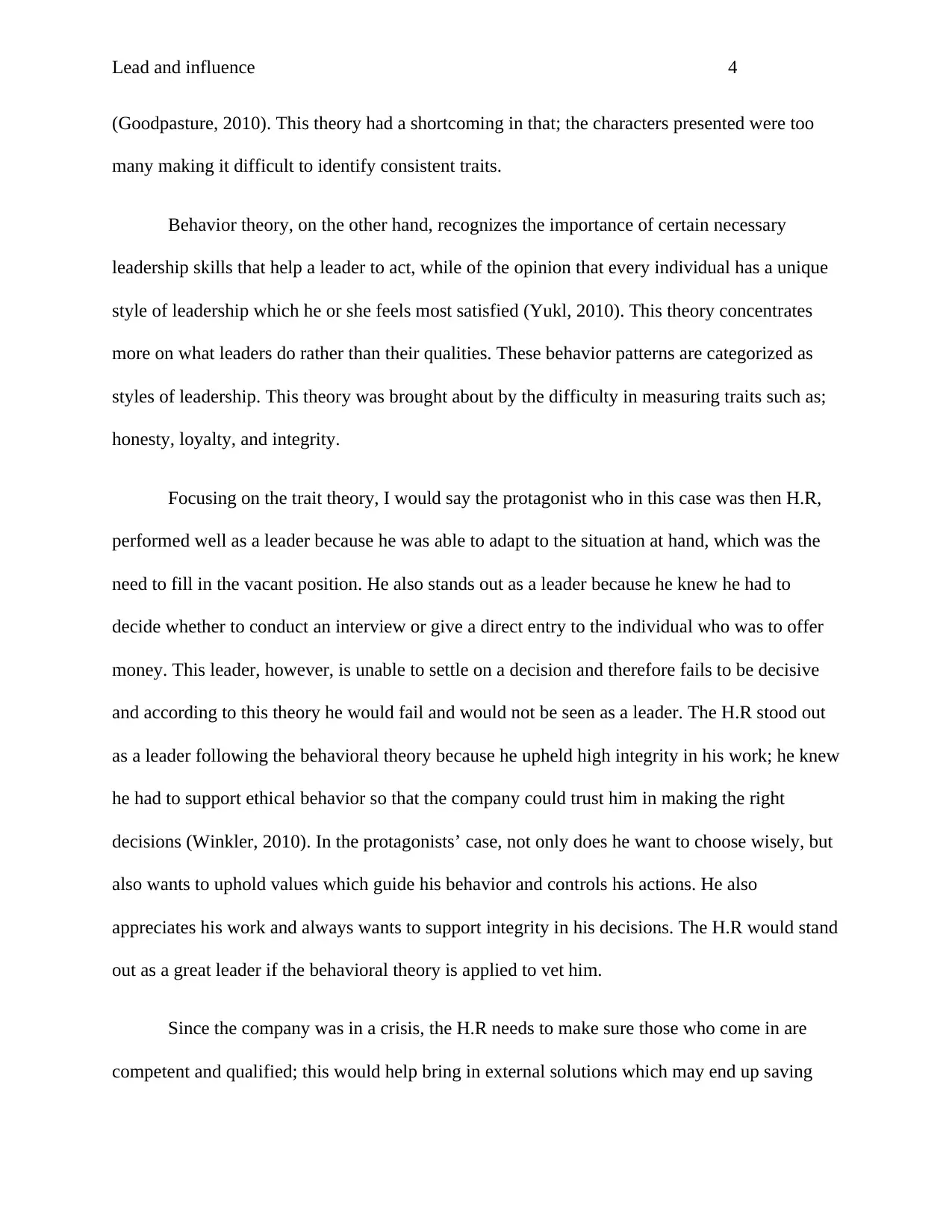
Lead and influence 4
(Goodpasture, 2010). This theory had a shortcoming in that; the characters presented were too
many making it difficult to identify consistent traits.
Behavior theory, on the other hand, recognizes the importance of certain necessary
leadership skills that help a leader to act, while of the opinion that every individual has a unique
style of leadership which he or she feels most satisfied (Yukl, 2010). This theory concentrates
more on what leaders do rather than their qualities. These behavior patterns are categorized as
styles of leadership. This theory was brought about by the difficulty in measuring traits such as;
honesty, loyalty, and integrity.
Focusing on the trait theory, I would say the protagonist who in this case was then H.R,
performed well as a leader because he was able to adapt to the situation at hand, which was the
need to fill in the vacant position. He also stands out as a leader because he knew he had to
decide whether to conduct an interview or give a direct entry to the individual who was to offer
money. This leader, however, is unable to settle on a decision and therefore fails to be decisive
and according to this theory he would fail and would not be seen as a leader. The H.R stood out
as a leader following the behavioral theory because he upheld high integrity in his work; he knew
he had to support ethical behavior so that the company could trust him in making the right
decisions (Winkler, 2010). In the protagonists’ case, not only does he want to choose wisely, but
also wants to uphold values which guide his behavior and controls his actions. He also
appreciates his work and always wants to support integrity in his decisions. The H.R would stand
out as a great leader if the behavioral theory is applied to vet him.
Since the company was in a crisis, the H.R needs to make sure those who come in are
competent and qualified; this would help bring in external solutions which may end up saving
(Goodpasture, 2010). This theory had a shortcoming in that; the characters presented were too
many making it difficult to identify consistent traits.
Behavior theory, on the other hand, recognizes the importance of certain necessary
leadership skills that help a leader to act, while of the opinion that every individual has a unique
style of leadership which he or she feels most satisfied (Yukl, 2010). This theory concentrates
more on what leaders do rather than their qualities. These behavior patterns are categorized as
styles of leadership. This theory was brought about by the difficulty in measuring traits such as;
honesty, loyalty, and integrity.
Focusing on the trait theory, I would say the protagonist who in this case was then H.R,
performed well as a leader because he was able to adapt to the situation at hand, which was the
need to fill in the vacant position. He also stands out as a leader because he knew he had to
decide whether to conduct an interview or give a direct entry to the individual who was to offer
money. This leader, however, is unable to settle on a decision and therefore fails to be decisive
and according to this theory he would fail and would not be seen as a leader. The H.R stood out
as a leader following the behavioral theory because he upheld high integrity in his work; he knew
he had to support ethical behavior so that the company could trust him in making the right
decisions (Winkler, 2010). In the protagonists’ case, not only does he want to choose wisely, but
also wants to uphold values which guide his behavior and controls his actions. He also
appreciates his work and always wants to support integrity in his decisions. The H.R would stand
out as a great leader if the behavioral theory is applied to vet him.
Since the company was in a crisis, the H.R needs to make sure those who come in are
competent and qualified; this would help bring in external solutions which may end up saving
Paraphrase This Document
Need a fresh take? Get an instant paraphrase of this document with our AI Paraphraser
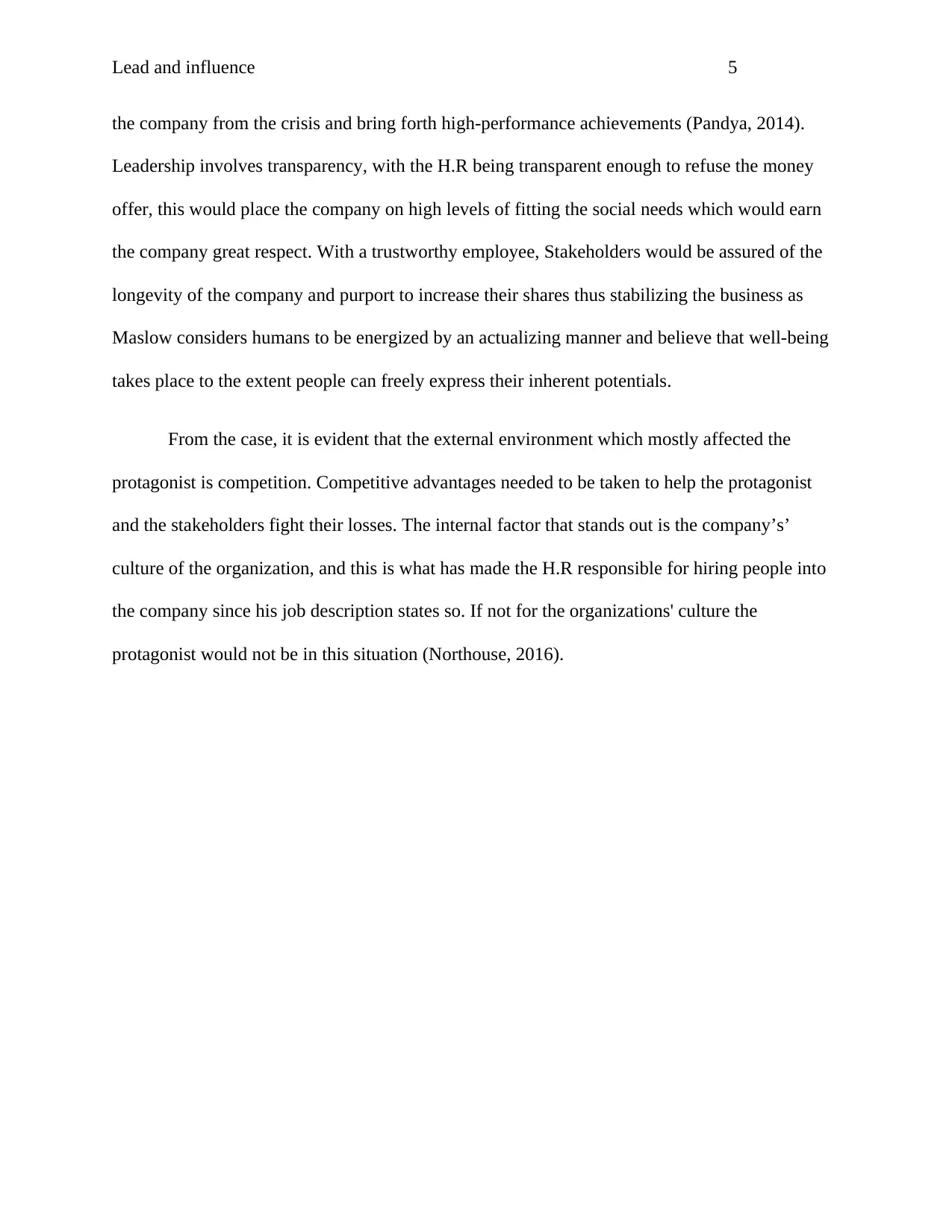
Lead and influence 5
the company from the crisis and bring forth high-performance achievements (Pandya, 2014).
Leadership involves transparency, with the H.R being transparent enough to refuse the money
offer, this would place the company on high levels of fitting the social needs which would earn
the company great respect. With a trustworthy employee, Stakeholders would be assured of the
longevity of the company and purport to increase their shares thus stabilizing the business as
Maslow considers humans to be energized by an actualizing manner and believe that well-being
takes place to the extent people can freely express their inherent potentials.
From the case, it is evident that the external environment which mostly affected the
protagonist is competition. Competitive advantages needed to be taken to help the protagonist
and the stakeholders fight their losses. The internal factor that stands out is the company’s’
culture of the organization, and this is what has made the H.R responsible for hiring people into
the company since his job description states so. If not for the organizations' culture the
protagonist would not be in this situation (Northouse, 2016).
the company from the crisis and bring forth high-performance achievements (Pandya, 2014).
Leadership involves transparency, with the H.R being transparent enough to refuse the money
offer, this would place the company on high levels of fitting the social needs which would earn
the company great respect. With a trustworthy employee, Stakeholders would be assured of the
longevity of the company and purport to increase their shares thus stabilizing the business as
Maslow considers humans to be energized by an actualizing manner and believe that well-being
takes place to the extent people can freely express their inherent potentials.
From the case, it is evident that the external environment which mostly affected the
protagonist is competition. Competitive advantages needed to be taken to help the protagonist
and the stakeholders fight their losses. The internal factor that stands out is the company’s’
culture of the organization, and this is what has made the H.R responsible for hiring people into
the company since his job description states so. If not for the organizations' culture the
protagonist would not be in this situation (Northouse, 2016).
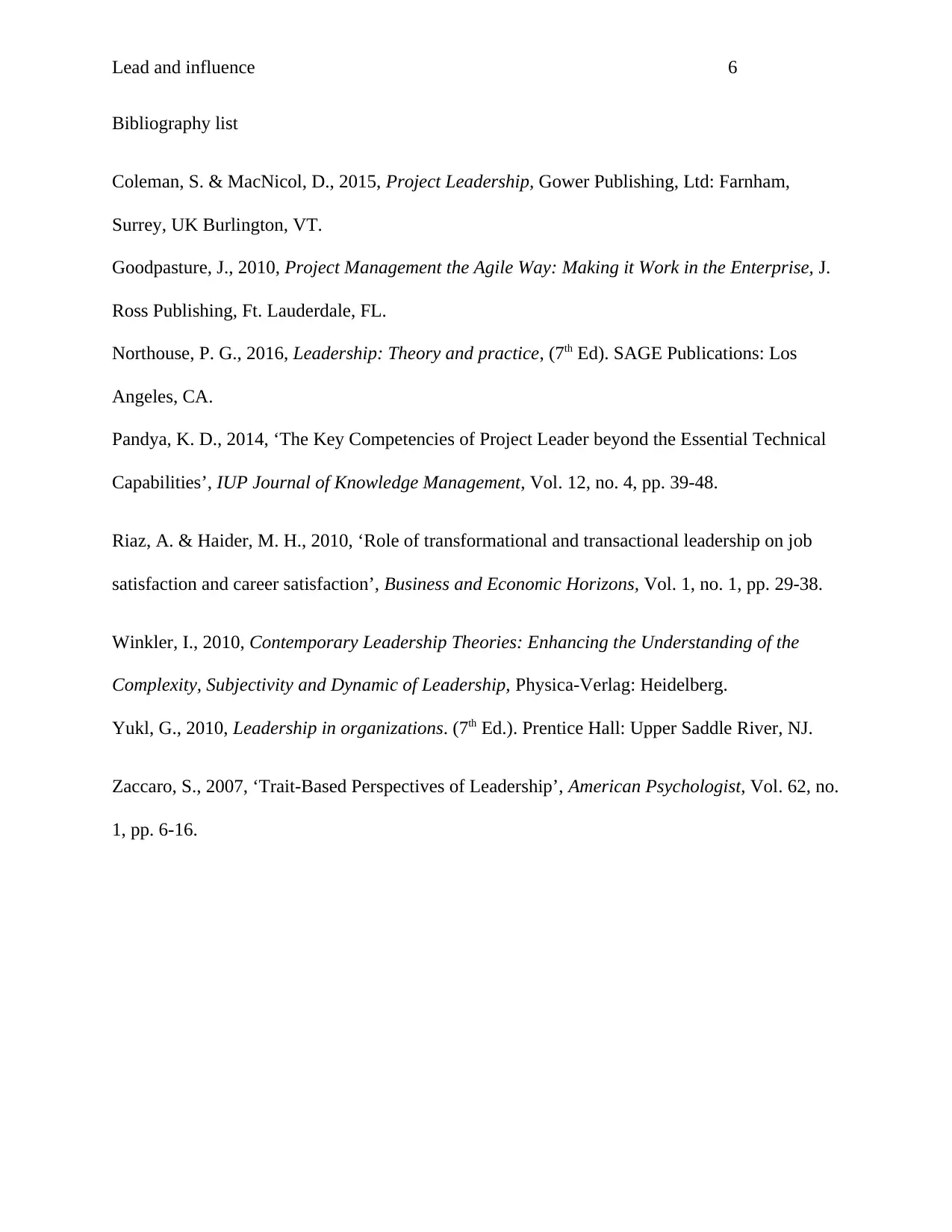
Lead and influence 6
Bibliography list
Coleman, S. & MacNicol, D., 2015, Project Leadership, Gower Publishing, Ltd: Farnham,
Surrey, UK Burlington, VT.
Goodpasture, J., 2010, Project Management the Agile Way: Making it Work in the Enterprise, J.
Ross Publishing, Ft. Lauderdale, FL.
Northouse, P. G., 2016, Leadership: Theory and practice, (7th Ed). SAGE Publications: Los
Angeles, CA.
Pandya, K. D., 2014, ‘The Key Competencies of Project Leader beyond the Essential Technical
Capabilities’, IUP Journal of Knowledge Management, Vol. 12, no. 4, pp. 39-48.
Riaz, A. & Haider, M. H., 2010, ‘Role of transformational and transactional leadership on job
satisfaction and career satisfaction’, Business and Economic Horizons, Vol. 1, no. 1, pp. 29-38.
Winkler, I., 2010, Contemporary Leadership Theories: Enhancing the Understanding of the
Complexity, Subjectivity and Dynamic of Leadership, Physica-Verlag: Heidelberg.
Yukl, G., 2010, Leadership in organizations. (7th Ed.). Prentice Hall: Upper Saddle River, NJ.
Zaccaro, S., 2007, ‘Trait-Based Perspectives of Leadership’, American Psychologist, Vol. 62, no.
1, pp. 6-16.
Bibliography list
Coleman, S. & MacNicol, D., 2015, Project Leadership, Gower Publishing, Ltd: Farnham,
Surrey, UK Burlington, VT.
Goodpasture, J., 2010, Project Management the Agile Way: Making it Work in the Enterprise, J.
Ross Publishing, Ft. Lauderdale, FL.
Northouse, P. G., 2016, Leadership: Theory and practice, (7th Ed). SAGE Publications: Los
Angeles, CA.
Pandya, K. D., 2014, ‘The Key Competencies of Project Leader beyond the Essential Technical
Capabilities’, IUP Journal of Knowledge Management, Vol. 12, no. 4, pp. 39-48.
Riaz, A. & Haider, M. H., 2010, ‘Role of transformational and transactional leadership on job
satisfaction and career satisfaction’, Business and Economic Horizons, Vol. 1, no. 1, pp. 29-38.
Winkler, I., 2010, Contemporary Leadership Theories: Enhancing the Understanding of the
Complexity, Subjectivity and Dynamic of Leadership, Physica-Verlag: Heidelberg.
Yukl, G., 2010, Leadership in organizations. (7th Ed.). Prentice Hall: Upper Saddle River, NJ.
Zaccaro, S., 2007, ‘Trait-Based Perspectives of Leadership’, American Psychologist, Vol. 62, no.
1, pp. 6-16.
⊘ This is a preview!⊘
Do you want full access?
Subscribe today to unlock all pages.

Trusted by 1+ million students worldwide
1 out of 6
Related Documents
Your All-in-One AI-Powered Toolkit for Academic Success.
+13062052269
info@desklib.com
Available 24*7 on WhatsApp / Email
![[object Object]](/_next/static/media/star-bottom.7253800d.svg)
Unlock your academic potential
Copyright © 2020–2025 A2Z Services. All Rights Reserved. Developed and managed by ZUCOL.





